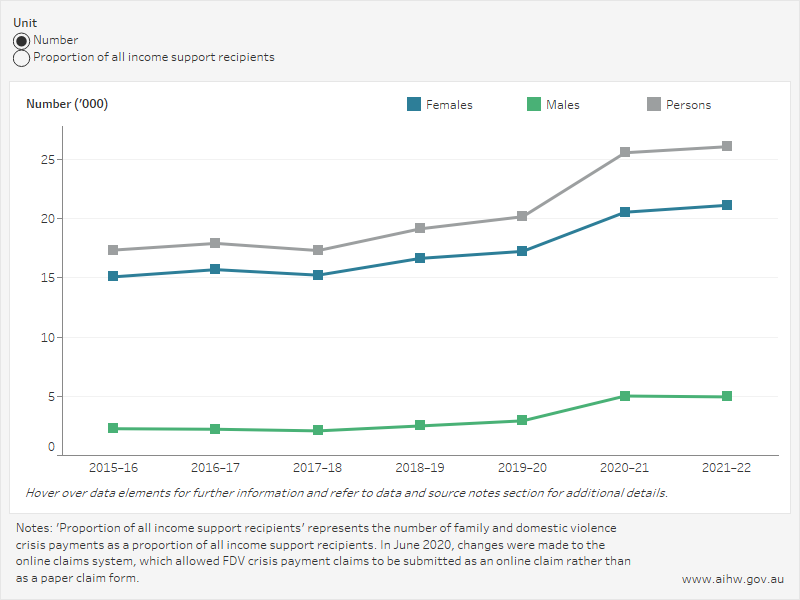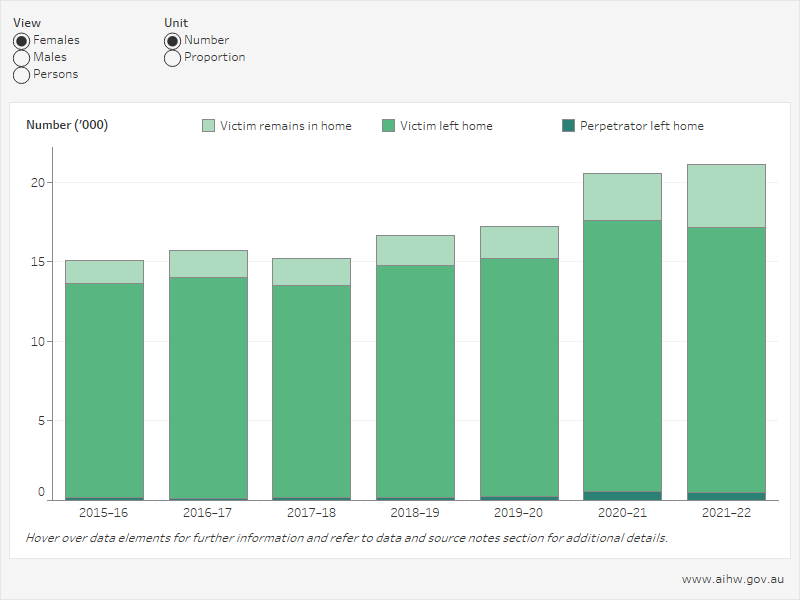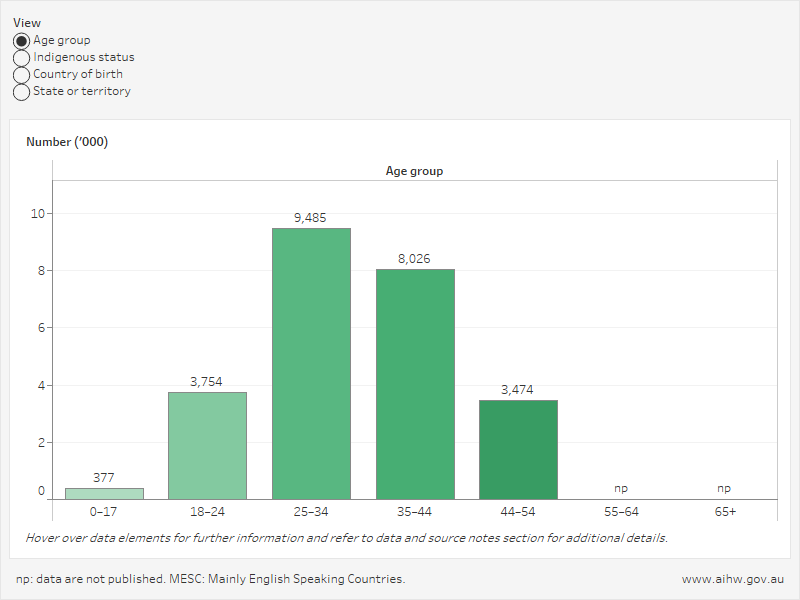Family and domestic violence Crisis Payments
People who are in severe financial hardship and have experienced changes in their living arrangements due to family and/or domestic violence, and are receiving, or are eligible to receive, an income support payment or ABSTUDY Living Allowance, may receive a one-off Crisis Payment. This payment is paid in addition to a person's income support payment. Data are drawn from Services Australia Data.
The visualisation below shows the number of family and domestic violence Crisis Payment claims granted per year and as a proportion of all income support recipients. Between 2015–16 and 2021–22, the number of claims granted increased by 50% (17,400 to 26,100). The proportion of income support recipients who received at least one family and domestic violence Crisis Payment each year increased slightly from 0.34% to 0.51%.
Claims granted for family and domestic violence Crisis Payments by gender, 2015–16 to 2021–22

Source data: Family and domestic violence Crisis Payments tables (63KB XLSX)
The visualisation below shows the number of family and domestic violence Crisis Payment claims granted per year by gender and sub-category of Crisis Payment. Between 2015–16 and 2021–22, the most common sub-category of family and domestic violence Crisis Payment each year was Victim left home, regardless of gender.
Claims granted for family and domestic violence Crisis Payments by gender and sub-category, 2015–16 to 2021–22

Source data: Family and domestic violence Crisis Payments tables (63KB XLSX)
The visualisation below allows users to explore the number of granted family and domestic violence Crisis Payment claims for different population groups. With the exception of Queensland, which had more claims than New South Wales and Victoria, the number of claims generally followed a pattern consistent with population size. Over a third (9,500 or 38%) of all granted claims were for people aged 25–34 years.
Claims granted for family and domestic violence Crisis Payments by select population groups, 2021–22

Source data: Family and domestic violence Crisis Payments tables (63KB XLSX)
The visualisation below allows users to explore the number of granted family and domestic violence Crisis Payment claims by other payment types received. It shows that in 2021–22, 2 in 5 (41% or 10,800) family and domestic claims were granted to people who were receiving Family Tax Benefit (FTB) at the end of the 2021–22 financial year, meaning they had dependent children in their care. It also shows that around 1 in 7 (15% or 3,900) people who received a family and domestic violence crisis payment in 2021–22 were receiving Disability Support Pension (DSP) at the time the Crisis Payment was granted.
Claims granted for family and domestic violence Crisis Payments by other payment types, 2021–22
Notes
- A person claiming Crisis Payment for Extreme Circumstances of Family and Domestic Violence must:
- be qualified (and payable) for income support;
- be in severe financial hardship;
- have left their home permanently and be unable to return home because of family and domestic violence, and have established or intend to establish a new home, or have remained in their home following family and domestic violence and the family member responsible has left or been removed from the home; and
- must have submitted their claim within 7 days after the extreme circumstance related to family and domestic violence occurred. In recognition that a claimant who has left their home due to family or domestic violence may be suffering from trauma, the 7-day claim period does not commence until they decide they cannot return to their home.
- A person can be granted a Crisis Payment due to being unable to return home and/or remaining in their home following removal of the family member up to four times in a 12-month period. As a result, count of payments may include multiple payments made to the same person.
- The main income support payments are:
- Age Pension
- Youth Allowance Student and Apprentice, ABSTUDY (Living Allowance), Austudy
- JobSeeker Payment (from 20 March 2020), Newstart Allowance (closed 20 March 2020)
- Parenting Payment Single and Parenting Payment Partnered
- Disability Support Pension and Carer Payment
- Other small payments: Special Benefit and payments that have now ceased (including Partner and Widow Allowance to January 2022, Wife Pension to March 2020, and Sickness Allowance to September 2020).
- Changes to eligibility for income support payments over time will affect the number of claims for Crisis Payments that are made.
- Changes to the claims process, including implementation and enhancements of an online claim system and changes to the referral process, may impact interpretation of time series data. In June 2020, changes were made to the online claims system which allowed FDV crisis payment claims to be submitted as an online claim rather than as a paper claim form.
- ‘Other Australians’ includes people who identified as non-Indigenous as well as 1,200 people who did not provide information relating to Indigenous status.
- Disability support payments were being received at the time family and domestic violence crisis payment was granted.
- Details relating to FTB for family and domestic violence crisis payment recipients is current at the time of data extraction (in this case at the end of the relevant financial year) and is not necessarily reflective of FTB status at the time a family and domestic violence crisis payment was granted. As FTB is not classified as an income support payment, people receiving or eligible for FTB only would not qualify for a crisis payment.
Sources
Services Australia Data (unpublished)


